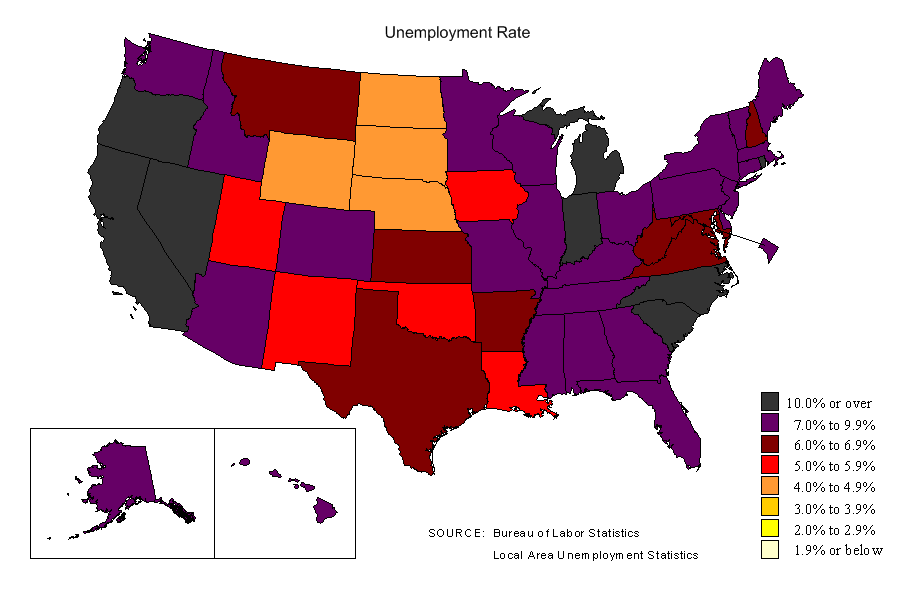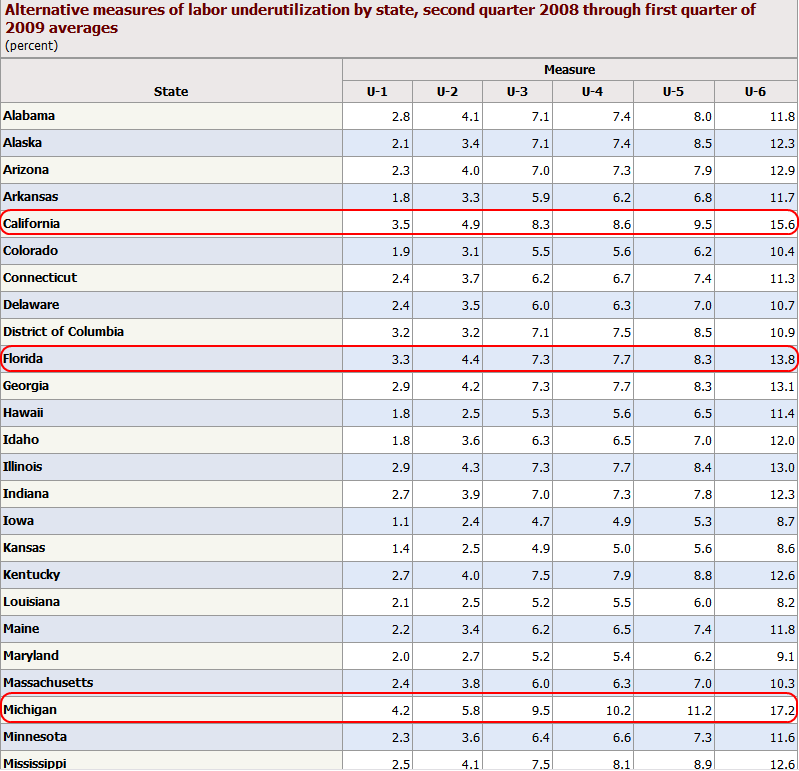State Unemployment Data: 7 States Now With Historical High Unemployment Rate. Michigan 22.8 Percent Unemployment Rate (U-6) with Official Government Data.
- 2 Comment
There have been many comparisons to the past with our current recession. For the most part, people are trying to find something familiar so they can have a better sense of where we are heading. The only problem is that there isn’t much in our own history to guide us forward. This is a unique and deep recession unlike anything we have seen since World War II. When I put together a post highlighting that 24,700,000 Americans are unemployed or underemployed some people questioned the actual number. The only issue is that this number is from official government data which if we look at the stress tests, tend to be conservative.
Even with government data, 7 states have now broken statewide historical unemployment averages. Those states are:
Oregon:Â Â Â Â Â Â Â Â Â Â Â Â Â Â Â Â Â Â Â Â Â Â 12.1%
South Carolina:Â Â Â Â Â Â Â Â Â Â 11.4%
California:Â Â Â Â Â Â Â Â Â Â Â Â Â Â Â Â Â Â 11.2%
North Carolina:Â Â Â Â Â Â Â Â Â Â 10.8%
Rhode Island:Â Â Â Â Â Â Â Â Â Â Â Â 10.5%
Florida:Â Â Â Â Â Â Â Â Â Â Â Â Â Â Â Â Â Â Â Â Â Â Â 9.7%
Georgia:Â Â Â Â Â Â Â Â Â Â Â Â Â Â Â Â Â Â Â Â Â 9.2%
Now of course if we go back to the Great Depression I’m sure we will see higher rates but we didn’t standardize data gathering back then. Much of our accurate data comes from the increased economic and social science study that occurred after the devastation brought on by the Great Depression.
If we were to map the unemployment rate on a nationwide map this is what it would look like:
You’ll notice that most of the devastation is hitting on both coasts. In fact, 6 out of the 7 states breaking statewide unemployment rates are on the coast. The Bureau of Labor and Statistics is now publishing select data on the U-6 measure of unemployment for certain timeframes. This is important because the media now realizes that the true employment situation is reflected in the U-6 figure. That is, those who are working part-time and looking for full-time work shouldn’t be counted as full-time employed. The difference between the headline U-3 number and the U-6 number is nearly double. That is why this recession feels much more profound than the 8.9 percent headline number.
If we run the numbers, a few states now have U-6 rates above 20 percent putting them near depression levels. Let us first take a look at the data to build our model:
Now you need to know that the above data runs from Q2 of 2008 to Q1 of 2009 and is averages. Since the unemployment rate has increased drastically over the last few months, the U-3 and U-6 data is much higher today. But using these averages we can get a good estimate to what the current U-6 data for each state is with the latest figures. We will try to figure out the current U-6 data for three states. We will look at Michigan, California, and Florida.
To figure out the current U-6 estimate, let us use the estimates provided by the BLS:
California:
(8.3 / 15.6 = 11.2 / x)
Florida:
(7.3 / 13.8 = 9.7 / x)
Michigan:
(9.5 / 17.2 = 12.6 / x)
The BLS even tells us that there is a close relation between all measures:
“Generally, all six measures move together over time, including across business cycles. Similarly, states that have high official unemployment rates tend to have high values for the other five measures; the reverse is true for states with low unemployment rates.”
We would expect this. That is why in the current data, the U-3 unemployment rate nationwide is 8.9 percent while the U-6 figure is 15.8 percent. If we solve for the above we get the following U-6 rate for the three states:
U-6:
Florida:Â Â Â Â Â Â Â Â Â 18.3%
California:Â Â Â Â 21%
Michigan:Â Â Â Â Â Â 22.8%
Is this too hard to believe? The average data already tells us that California is at 15.6 percent and Michigan is at 17.2 percent and we don’t even include the most devastating employment losses of 2009. Some states are already seeing unemployment situations that are rivaling Great Depression numbers and what do you think will happen to a state like Michigan with two of the big three automakers now bankrupt or on the verge? That is why we are living through a new austerity and we will not be seeing a 2nd half recovery, certainly not in the 7 states with record unemployment rates.
If you enjoyed this post click here to subscribe to a complete feed and stay up to date with today’s challenging market!2 Comments on this post
Trackbacks
-
VicinSea said:
Very soon, we are going to have to drop this system of analyzing our worker base. This government formula is out of date and gives a false sense of sustainability. The real number of people out of work and underemployed is closer to 60% in Michigan and about 40% across the US but the number that really counts is the US Labor Market which is the number of jobs available in the US–currently about 135 Million. 135 Million workers to support 325 Million people living in the US (including about 15 Million illegals. Every worker is supporting themselves and 1.4 other people Picture a single mom with 1.4 kids and you can get an idea of the quality of life to expect under these conditions.
The current governmental system of artificially moving people off the unemployment numbers to other categories(like full time student, retired or disabled) doesn’t fix the problem of the record low number of jobs available to support everyone in the system.
Right now we need about 27 Million new jobs just to balance the ratio and about 50 Million Jobs to ensure growth and stability. And, those jobs have to be primarily people who make things–paper shuffling will not help our trade deficits and debt. The 3 Million jobs created so far is barely a drop in the bucket towards filling that need.
May 17th, 2009 at 8:08 am -
makesenseofit said:
Our standard of living is definitely in a free fall. The average wage is decreasing at an alarming rate. In order to compete with China we
need to become a third world country unike we have ever seen.
The bottom feeders will be eating out of garbage dumpsters in the distant future if a cure is not found for the negative devastation
economically in this country.May 18th, 2009 at 4:27 pm


 If you enjoyed this post click here to subscribe to a complete feed and stay up to date with today’s challenging market!
If you enjoyed this post click here to subscribe to a complete feed and stay up to date with today’s challenging market!